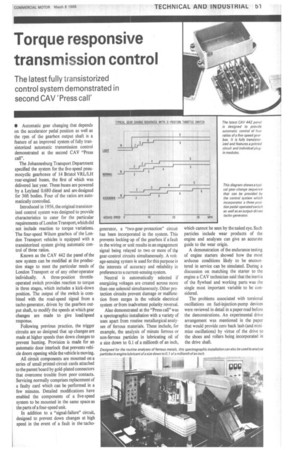Torque responsive transmission control
Page 53

If you've noticed an error in this article please click here to report it so we can fix it.
The latest fully transistorized control system demonstrated in second CAV ' Press call'
• Automatic gear changing that depends on the accelerator pedal position as well as the rpm of the gearbox output shaft is a feature of an improved system of fully transistorized automatic transmission control demonstrated at the second CAV "Press call".
The Johannesburg Transport Department specified the system for the five-speed pneumocyclic gearboxes of 14 Bristol VRL/LH rear-engined buses, the first of which was delivered last year. These buses are powered by a Leyland 0.680 diesel and are designed for 36ft bodies. Four of the ratios are automatically controlled.
Introduced in 1956, the original transistorized control system was designed to provide characteristics to cater for the particular requirements of London Transport, which did not include reaction to torque variations. The four-speed Wilson gearbox of the London Transport vehicles is equipped with a transistorized system giving automatic control of three ratios.
Known as the CAV 442 the panel of the new system can be modified at the production stage to meet the particular needs of London Transport or of any other operator individually. A three-position throttleoperated switch provides reaction to torque in three stages, which includes a kick-down position. The output of the switch is combined with the road-speed signal from a tacho-generator, driven by the gearbox output shaft, to modify the speeds at which gear changes are made to give load/speed response.
Following previous practice, the trigger circuits are so designed that up changes are made at higher speeds than down changes to prevent hunting. Provision is made for an automatic door interlock that prevents vehicle doors opening while the vehicle is moving.
All circuit components are mounted on a series of small printed-circuit cards attached to the parent board by gold-plated connectors that overcome trouble from poor contacts. Servicing normally comprises replacement of a faulty card which can be performed in a few minutes. Detailed modifications have enabled the components of a five-speed system to be mounted in the same space as the parts of a four-speed unit.
In addition to a "signal-failure" circuit, designed to prevent down changes at high speed in the event of a fault in the tacho
generator, a "two-gear-protection" circuit has been incorporated in the system. This prevents locking-up of the gearbox if a fault in the wiring or unit results in an engagement signal being relayed to two or more of the gear-control circuits simultaneously. A voltage-sensing system is used for this purpose in the interests of accuracy and reliability in preference to a current-sensing system.
Neutral is automatically selected if energizing voltages are created across more than one solenoid simultaneously. Other protection circuits prevent damage or malfunction from surges in the vehicle electrical system or from inadvertent polarity reversal.
Also demonstrated at the "Press call" was a spectographic installation with a variety of uses apart from routine metallurgical analyses of ferrous materials. These include, for example, the analysis of minute ferrous or non-ferrous particles in lubricating oil of a size down to 0.1 of a millionth of an inch, which cannot be seen by the naked eye. Such particles include wear • products of the engine and analyses can give an accurate guide to the wear origin.
A demonstration of the endurance testing of engine starters showed how the most arduous conditions likely to be encountered in service can be simulated. During a discussion on matching the starter to the engine a CAV technician said that the inertia of the flywheel and working parts was the single most important variable to be considered.
The problems associated with torsional oscillations on fuel-injection-pump devices were reviewed in detail in a paper read before the demonstrations. An experimental drive arrangement was mentioned in the paper that would provide zero back lash (and minimize oscillations) by virtue of the drive to the shoes and rollers being incorporated in the drive shaft.




































































































































